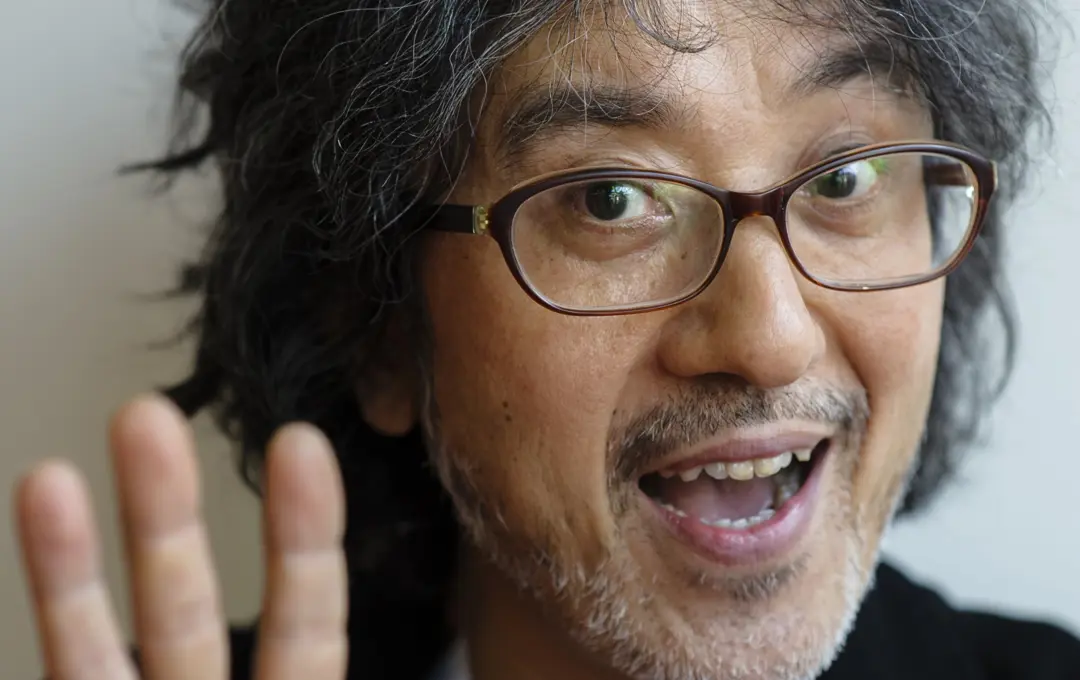Bold, mischievous and unpredictable
Ryôji Arai is a Japanese picture book artist living in Tokyo. His production of picture books is both large and varied – from small books for toddlers, to picture books of nonsense, fairytales and poetry, both with his own texts and those of other writers. He has also worked with advertising, magazine illustration and theatre set design.
 Photo: Stefan Tell
Photo: Stefan TellQuick facts
The jury’s motivation
Ryôji Arai is an illustrator with a style all of his own: bold, mischievous and unpredictable. His picturebooks glow with warmth, playful good humour and an audacious spontaneity that appeals to children and adults alike. In adventure after adventure, colour flows through his hands in an almost musical way. As a medium for conveying stories to children, his art is at once genuine and truly poetic, encouraging children to paint and to tell their own stories.
Arai studied art at Nippon University. His production of picture books is both large and varied – from small books for toddlers, to picture books of nonsense, fairytales and poetry, both with his own texts and those of other writers. He has also worked with advertising, magazine illustration and theatre set design.
His illustrated books have won him a number of awards in his native Japan and around the world; the newcomer's prize Fourth Choice in Japan 1986, the Grand Award for new illustrators 1990, the publisher Shogakkan's 1997 award for children's literature for Uso tsuki no tsuki (The Lying Moon), the Special Award at the 1999 Bologna Book Fair for Nazo nazo no tabi (A Journey of Riddles) together with Chihiro Ishizu, and the 31st picture book award from the publisher Kodansha for Mori no ehon (A Forest Picture Book, 1999) together with the poet Hiroshi Osada.
Colourful and fervent, lavish and fastidious
This text was written in 2005 by members of the award jury.
Ryôji Arai is a japanese illustrator, born in Yamagata in 1956 and resident in Tokyo. He studied art at Nippon University. His production of picture books is both large and varied – from small books for toddlers, to picture books of nonsense, fairytales and poetry, both with his own texts and those of other writers. He has also worked with advertising, magazine illustration and theatre set design.
His illustrated books have won him a number of awards in his native Japan and around the world; the newcomer's prize Fourth Choice in Japan 1986, the Grand Award for new illustrators 1990, the publisher Shogakkan's 1997 award for children's literature for Uso tsuki no tsuki (The Lying Moon), the Special Award at the 1999 Bologna Book Fair for Nazo nazo no tabi (A Journey of Riddles) together with Chihiro Ishizu, and the 31st picture book award from the publisher Kodansha for Mori no ehon (A Forest Picture Book, 1999) together with the poet Hiroshi Osada.
In the pictorial world of Ryôji Arai, nothing is impossible. The hustle and bustle of city life coexists with the tranquillity of the forest, the calm of the sea. He paints aromas and feelings, music and dance, movement and silence, mostly in watercolour or gouache. Many of his figures, often with highly unusual names, are prone to wandering through various landscapes, as in the highly stylised Yukkkuri to Jojoni, 1991 (Slowly and Gradually), where the boy, Slowly, with his accordion and songs, wanders out of his green (the countryside), and the girl, Gradually, dances out of her blue (the city). They meet in red both in the country and city, wander together for a while, dance, play, sing and separate again without anything special having happened. Except, perhaps, that Slowly thinks that his singing has got a little better and Gradually feels she is beginning to dance rather well.
Thus it is that Arai seems to proclaim, in book after book, that the small events in life are worth telling, the slightest movements worth recording.
In one of his most original picture books, Hajimari, hajimari, 1994 (Performance, Performance!), the principal character is a theatre that flies out of the darkness and gives performances in which "I" appears in a series of various tableaux between curtain falls. In a central scene "I" is revealed as an artist:
So Performance! Performance! said : "Performance! Performance!". And he hauled up the curtain. I drew a picture on the wall together with myself aged five.
In the picture we see an adult artist and a child, both left-handed and wearing white sombreros, painting a typically swarming Arai universe: the adult's diagonally placed cars, trains, buildings and musicians clad in folklore costumes with fantastic hats, blend naturally with the five-year-old's childish dinosaurs and super heroes, chubby cats and giant snails. The painting is colourful and fervent, lavish and fastidious. Nothing is overtly expressed. As the theatre audience, we are left to interpret what we see from the best seats in the house, before the curtain falls for the final time and dawn approaches:
It's over now, it's over now!, said Performance! Performance!, and disappeared into the distance.
Arai has become a highly-regarded illustrator in Japan, renowned for his desire to stimulate children's individual thinking, and to champion freedom, poetry and imagination in the rather strictly organised society of Japan. He displays enormous respect for children, their way of thinking and being, maintaining a child's point of view in everything he does. And in titles referring to relaxation and smiles, he especially appears to set great store by showing us the comforting lack of order in our existence and how we, too, can cope with time.
Basu ni notte, 1992 (Taking the Bus), for example, is a story about time and patience, and about a boy who wants to go on a long journey. His sits in the bus shelter with his luggage and his tiny radio. Time passes, and various extraordinary things go past. But no bus. Gradually the picture starts to tilt to the right, giving a feeling of dizziness, of the passing of time, whilst the boy sits helplessly rooted to the spot. Various people pass by, but no bus. Night falls. The boy sleeps on the tiny bench under a boundless night sky. Morning arrives in a burst of sunlight. Finally, much later in the day, the bus arrives, an enormous contraption that brakes in a cloud of smoke and dust. The bus turns out to be full, and disappears in another cloud of dust. The boy stays put for a while, picks up his luggage and sets of for the horizon on foot instead.
In Su-su to neru-neru, 1996 (Snoozy and Night-Night), we encounter two children who cannot sleep and who decide to tell each other stories until they are tired. And what stories they are! We follow the children through fantastic landscapes with all the surrealistic qualities of our dreams. Arai's use of fantasy and colour is superb, reminiscent of Matisse and Picasso.
The award-winning A Forest Picture Book, 1999, based on a prose poem by Hiroshi Osada, is also a finely-nuanced poetic story. It begins in a forest depicted in soft shades of green. Our companions in the forest are a tiny butterfly and a disembodied voice. "What are you longing for?", it asks. It leads us slowly to a shimmering lake, a fragrant sea of flowers, to freshly-baked buns… "What are you longing for?", we ask the voice, to which the reply is "I long to hold the one I love by the hand, to look into my beloved's eyes."
The illustration here is a masterpiece of simplicity and expressive power. The lovers are two tiny houses not far apart from each other, painted in evocative watercolour. One of them has a small, coquettish ribbon on its roof. The narrow road which links them together in a soft arc has two hands meeting in the middle… an unexpected and striking metaphor for love.
We then return to the silence of the forest and the slow passing of time. Morning. Evening. Night. Summer. Autumn. Spring. A hundred years pass by, and the voice whispers: "What are you longing for? Where do you hide your treasures?"
In a world where the pace of life grows ever faster, the book seeks to remind us of the joys that are to be found if only we are prepared to wait for them.
In his profoundly original book illustrations, Ryôji Arai gets audaciously close to the world of the child, proving that he maintains spirited contact with the five-year-old inside him. He is also aware of the extent to which five-year-olds all over the world share experiences in common. On his website there is currently a small, charming and child-friendly online picture book, where one feels a sense of how four and five-year-olds talk out their games in an almost imperceptible interaction. It helps us become aware that, despite distances and cultural differences, childhood is a truly universal phenomenon:
Hello, hello, this is my little corner of likes
"I like books, especially books with nothing in them."
What sort of books are they?, I ask.
And you get a little cross. "Books", is all you say.
I see, that must be interesting, I say.
"Yeah", you say. "Nothing special."
What can you see in them? "Today I saw a white tunnel."
Anything else? "No, just that."
Shall we play? "But that's what I am doing…Ha!"
I like it when you take a deep breath.
See you!

Discover our laureates
The Astrid Lindgren Memorial Award is awarded to authors, illustrators and narrators, but also to people or organizations that work to promote reading.
Find out more about the laureates
Children have the right to great stories
To lose yourself in a story is to find yourself in the grip of an irresistible power. A power that provokes thought, unlocks language and allows the imagination to roam free. The Astrid Lindgren Memorial Award was created in 2002 by the Swedish government to promote every child’s right to great stories.
Find out more about the award